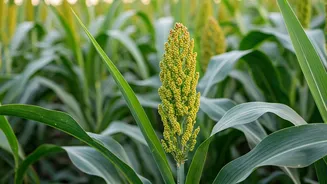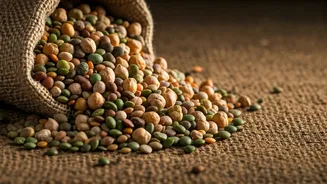Sorghum's Potential Unveiled
High-biomass sorghum hybrids are emerging as promising candidates for biofuel and animal feed. The success of these hybrids hinges largely on efficient
nitrogen use. Nitrogen is a critical nutrient, essential for plant growth and development, particularly influencing biomass production. When nitrogen is applied appropriately, sorghum plants exhibit improved photosynthetic rates, leading to greater accumulation of dry matter in stems and leaves. This translates into increased yields and enhanced feedstock quality, crucial factors for profitability in agriculture. Understanding and implementing optimal nitrogen management practices are thus paramount for maximizing the potential of these high-yielding sorghum varieties. Careful consideration of factors such as soil type, climate conditions, and specific hybrid characteristics is essential for tailoring nitrogen application strategies to achieve the best results.
Nitrogen's Impact Explained
Nitrogen plays a pivotal role in numerous plant functions, notably in the synthesis of chlorophyll, the green pigment responsible for photosynthesis. Adequate nitrogen supply promotes robust leaf development and enhances the plant's capacity to capture sunlight. This process directly correlates with increased biomass accumulation. Furthermore, nitrogen influences protein synthesis, which is vital for cell structure and enzyme activity, further accelerating growth. The effects of nitrogen fertilization extend beyond biomass. Nitrogen can influence the chemical composition of sorghum, affecting the digestibility and nutritional value of the feedstock. Efficient nitrogen management not only maximizes yield but also optimizes the quality of the harvest. Careful attention to nitrogen application timing, method, and dosage is essential to ensure that nitrogen is available to the plants when it's needed most, thereby reducing losses and maximizing benefits.
Optimizing Nitrogen Application
Effective nitrogen management involves a range of practices. Soil testing is essential to determine baseline nitrogen levels and to inform precise application rates. Applying the right amount of nitrogen at the appropriate time is crucial. Split applications, where nitrogen is applied in multiple doses throughout the growing season, are often more effective than a single large application. This approach reduces nitrogen losses through leaching or volatilization, making it available to the plant when needed. The method of application also matters. Incorporating nitrogen fertilizers into the soil can improve efficiency compared to surface application. Choosing the right type of nitrogen fertilizer, considering factors like cost, availability, and release characteristics, is another key decision. Moreover, adopting precision agriculture techniques, such as using variable rate nitrogen applicators guided by sensors, can further refine nitrogen management, leading to improved resource use and environmental benefits.
Benefits of Efficient Use
Optimizing nitrogen use in high-biomass sorghum hybrids offers multiple advantages. Increased yields represent the most immediate benefit. By providing the plants with the nitrogen they need, biomass production is maximized, and greater quantities of sorghum can be harvested. Improved feedstock quality, including enhanced nutritional value and digestibility, is another significant benefit. This is particularly crucial for animal feed, as higher-quality feedstock can lead to better animal performance. In addition, efficient nitrogen use contributes to environmental sustainability. By reducing the amount of nitrogen lost to the environment, through practices like careful timing and precise application, the risk of water and air pollution is minimized. This can reduce nitrogen runoff into water bodies, and it also lessens the emission of greenhouse gases. Overall, efficient nitrogen management leads to more profitable and sustainable sorghum production.
Future Research Directions
Ongoing research is exploring new strategies to further refine nitrogen management in sorghum. One area of focus involves identifying sorghum hybrids that are more efficient at utilizing nitrogen. Researchers are also investigating the role of soil microbes in nitrogen cycling. Understanding how these microbes influence nitrogen availability and uptake can open avenues for improved management. Precision agriculture tools, such as remote sensing and drone technology, offer opportunities for real-time monitoring of crop nitrogen status, enabling customized fertilization strategies. Another key area of investigation includes exploring the interaction between nitrogen and other nutrients, such as phosphorus and potassium, to optimize overall plant nutrition. By continuing to innovate and investigate the complexities of nitrogen dynamics, the agricultural sector can continually improve the efficiency and sustainability of sorghum production, ensuring its long-term viability.









